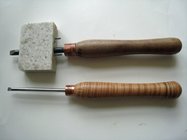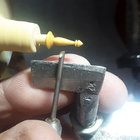-
It's time to cast your vote in the December 2025 Turning Challenge. (click here for details) -
Congratulations to Pat White for "Sicilian Mosaic" being selected as Turning of the Week for December 29, 2025 (click here for details) -
Welcome new registering member. Your username must be your real First and Last name (for example: John Doe). "Screen names" and "handles" are not allowed and your registration will be deleted if you don't use your real name. Also, do not use all caps nor all lower case.
You are using an out of date browser. It may not display this or other websites correctly.
You should upgrade or use an alternative browser.
You should upgrade or use an alternative browser.
Tiny skew
- Thread starter john lucas
- Start date
I use tiny skews a lot myself. One of the nice features is that it is almost impossible to get a catch no matter which part of the edge is contacting the wood.
I have no need for a tiny skew since I can do a skew like cut with the wing of just about any gouge and that is usually one that I have in hand.
Tom Gall
TOTW Team
John, ... looks like you need to smooth out that tool rest !!! 
Nice one John, have thought of making one also.
The smallest skew I have is 1/4", and I rarely use it. At an AAW symposium years ago, I watched Alan Lacer turn a small piece with (IIRC) a 1-1/2" skew. But I don't have his skill level, so I generally use a 1/2" skew.No matter what size your skew is they still work the same. This is not my smallest skew.
I use quarter-inch and half-inch round skews. To facilitate sharpening, I use the jig shown here to hold the faces of the skews parallel to the rim of the grinding wheel. The jig has a barb next to the through-hole for each size skew. There is a corresponding hole in the inner end of each handle.
I used some scrap Corian for my jig, but a piece of hard wood would work as well.
I used some scrap Corian for my jig, but a piece of hard wood would work as well.

Last edited:
Denis can you please explain I am having a mental aberration
The jig has a barb next to the through-hole for each size skew. There is a corresponding hole in the inner end of each handle.
The jig has a barb next to the through-hole for each size skew. There is a corresponding hole in the inner end of each handle.
john lucas
AAW Forum Expert
I just sharpen by eye which is much easier with CBN wheels because they run so true. My mini skews are initially shaped by hand on a 600 grit hone under my 20x stereo microscope. I have skews down to .008".
Brian, I guess I was not clear. Consider the upper shew in the picture. If you pushed the skew to the left, the barb would enter a hole in the end of the handle, preventing any rotation of the skew.Denis can you please explain I am having a mental aberration
The jig has a barb next to the through-hole for each size skew. There is a corresponding hole in the inner end of each handle.
John, you have me beat. My smallest is a 1/8 in flat skew. Regarding sharping of a round screw, it is analogous to the sharpening of a gouge. If you are good at it, freehand sharpening is fastest. Otherwise jig sharpening is the way to go for most turners.I just sharpen by eye which is much easier with CBN wheels because they run so true. My mini skews are initially shaped by hand on a 600 grit hone under my 20x stereo microscope. I have skews down to .008".
Sharpening a round skew freehand raises another issue: If you miss your aim and grind off one of the corners of the cutting edge, you will have to grind down all of the rest of the edge to regain the original shape. This can be waistefull of time and money. With a gouge, an error usually requires only a bit of blending in of the grind.
john lucas
AAW Forum Expert
All you need is a light touch. You can feel when your on the bevel if you use a light touch. Especially with the CBN wheels

